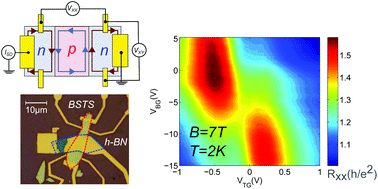Topological insulator n–p–n junctions in a magnetic field†
Abstract
Electrical transport in three dimensional topological insulators (TIs) occurs through spin-momentum locked topological surface states that enclose an insulating bulk. In the presence of a magnetic field, surface states get quantized into Landau levels giving rise to chiral edge states that are naturally spin-polarized due to spin momentum locking. It has been proposed that p–n junctions of TIs exposed to external magnetic fields can manifest unique spin dependent effects, apart from forming basic building blocks for highly functional spintronic devices. Here, for the first time we study electrostatically defined n–p–n junctions of dual-gated devices of the three dimensional topological insulator BiSbTe1.25Se1.75 in the presence of a strong magnetic field, revealing striking signatures of suppressed or enhanced electrical transport depending upon the chirality of quantum Hall edge states created at the n–p and p–n junction interfaces. Theoretical modeling combining the electrostatics of the dual gated TI n–p–n junction with the Landauer Buttiker formalism for transport through a network of chiral edge states explains our experimental data. Our work not only opens up a route towards exotic spintronic devices but also provides a test bed for investigating the unique signatures of quantum Hall effects in topological insulators.



 Please wait while we load your content...
Please wait while we load your content...